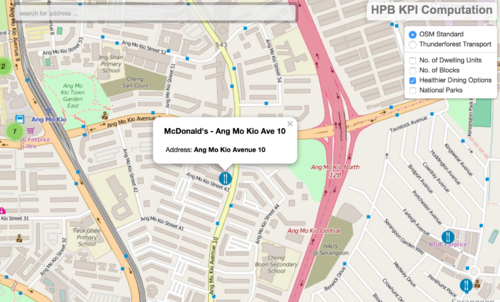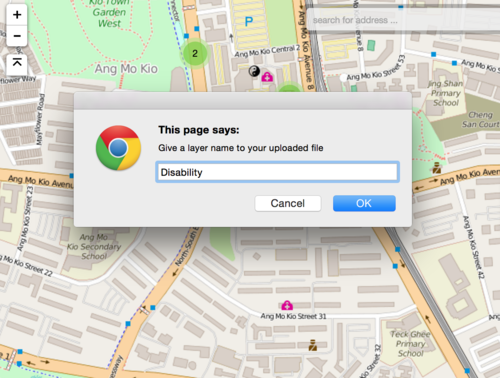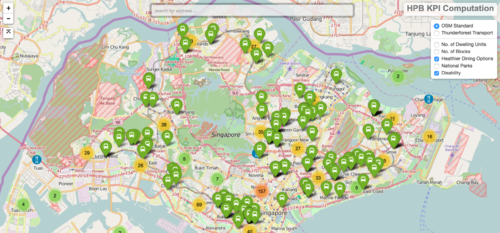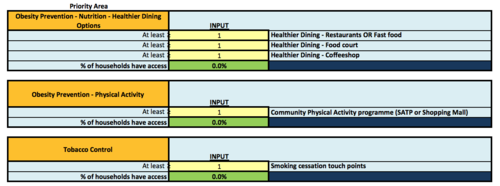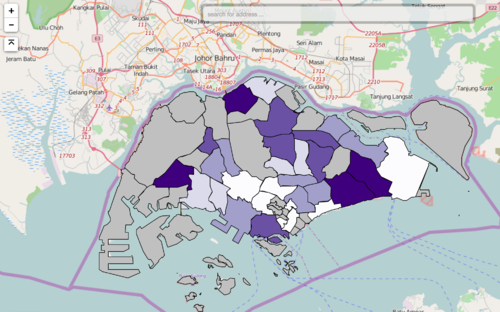Difference between revisions of "Griffins Proposal"
| Line 33: | Line 33: | ||
One of the key visualisation feature is allowing users to toggle, view and overlay map layers, on top of base layers from OpenStreetMap (OSM). Attributes of each location can be displayed on mouseover and users may customise the colours used to represent pointers on different map layers according to their own preferences. | One of the key visualisation feature is allowing users to toggle, view and overlay map layers, on top of base layers from OpenStreetMap (OSM). Attributes of each location can be displayed on mouseover and users may customise the colours used to represent pointers on different map layers according to their own preferences. | ||
| − | <br><br> | + | [[File:Scopeofwork1.png|500px|frameless|center|Pop-up box to display details of each point, a side bar to toggle base map and different map layers and a search box to search for addresses or postal codes]] |
| + | <small><center><i>Pop-up box to display details of each point, a side bar to toggle base map and different map layers and a search box to search for addresses or postal codes</i></center></small><br> | ||
| + | |||
| + | The function to upload a GEOJson or KML would be included, to allow users to plot their own map layers, and introduce new amenities into the analysis. | ||
| + | |||
| + | [[File:Scopeofwork2.png|500px|frameless|center|Icon at the top left corner allows user to upload new layers and name it ]] | ||
| + | <small><center><i>Icon at the top left corner allows user to upload new layers and name it </i> | ||
| + | </center></small> | ||
| + | <br> | ||
| + | [[File:Scopeofwork3.png|500px|frameless|center|New layer will be displayed and the sidebar will be updated accordingly]] | ||
| + | <small><center><i>New layer will be displayed and the sidebar will be updated accordingly | ||
| + | </i></center></small> | ||
| + | |||
| + | <u>KPI Calculations</u><br> | ||
| + | To allow users to calculate the KPI, a form would be required to allow users to input the buffer radius and type of amenities to search for within the radius. Based on the number of amenities that falls within the user-defined buffer area, the HDB blocks will be classified into high risk, medium risk, and low risk blocks. | ||
| + | <p> | ||
| + | HPB currently have 3 priority areas and HDB block’s risk level is determined by the number of priority areas, whose criteria were met. | ||
| + | |||
| + | [[File:Scopeofwork4.png|500px|frameless|center]] | ||
| + | <i><small><center> | ||
| + | High risk – HDB blocks that do not meet any of the criteria <br> | ||
| + | Moderate risk – HDB blocks that meet 1 of the criteria (any 1 of the 3)<br> | ||
| + | Low risk – HDB blocks that meet 2 of the criteria (any 2 of the 3) | ||
| + | </center></small></i> | ||
| + | |||
| + | The different risk levels will be visualised in the form of a choropleth map, grouped by planning area as well. This can allow the staff to identify planning areas with greater density of high blocks, or planning areas with higher concentration of low risk blocks. For the staff to further gain insights, tables and charts can generated to reveal the number of amenities within the planning area, highlighting amenities that is severely lacking, or over supplied. | ||
| + | |||
| + | [[File:Scopeofwork5.png|500px|frameless|center|Choropleth map by planning area]] | ||
| + | <small><center><i>Choropleth map by planning area | ||
| + | </i></center></small><br> | ||
| + | |||
<div style="background: #0081a1; padding: 5px; font-weight: bold; line-height: 1em; text-indent: 15px; border-left: #FF8819 solid 32px; font-size: 16px"><font color="#fff">Data</font></div> | <div style="background: #0081a1; padding: 5px; font-weight: bold; line-height: 1em; text-indent: 15px; border-left: #FF8819 solid 32px; font-size: 16px"><font color="#fff">Data</font></div> | ||
The following datasets would be required for this project | The following datasets would be required for this project | ||
Revision as of 13:53, 28 February 2016
| Home | Project Proposal | Project Management | Deliverables |
|---|
The Health Promotion Board (HPB) was established as a statutory board under the Ministry of Health in 2001 with a vision to build a nation of healthy people. HPB organises many Health Promotion programmes and requires many tools to assist them in planning to ensure efficient outreach and maximize public resources.
The current process at HPB is manually intensive, as staff are required to do perform analysis in selecting suitable areas for their outreach programmes, and this is largely done by calculating their KPI on excel spreadsheets. In addition, new colleagues typically have difficulties picking up technical skills related to GIS (such as using QGIS), and hence, are very reliant on a small group of staff that with the technical skills.
Our project aims to provide a custom GIS platform that will reduce manual data entry, is easy to use, and will enable the staff to gain greater insights into the data they currently possess.
This platform will be in the form of an interactive and visual web application that utilises GIS functions for geospatial planning and analysis.
The web application will compute and analyse HPB KPI reporting metrics - i.e. the percentage of HDB blocks that meet the user-defined criterion. Based on the criteria set by the user, the HDB blocks will be grouped into high, medium and low risk. We also aim to provide HDB with the option of viewing data by planning area, to allow HPB to analyse the spread of the high, medium and low risks of HDB blocks at a bigger scale.
Our scope of work includes building a web application that would run on a SVY21 projection.
Visualisation
One of the key visualisation feature is allowing users to toggle, view and overlay map layers, on top of base layers from OpenStreetMap (OSM). Attributes of each location can be displayed on mouseover and users may customise the colours used to represent pointers on different map layers according to their own preferences.
The function to upload a GEOJson or KML would be included, to allow users to plot their own map layers, and introduce new amenities into the analysis.
KPI Calculations
To allow users to calculate the KPI, a form would be required to allow users to input the buffer radius and type of amenities to search for within the radius. Based on the number of amenities that falls within the user-defined buffer area, the HDB blocks will be classified into high risk, medium risk, and low risk blocks.
HPB currently have 3 priority areas and HDB block’s risk level is determined by the number of priority areas, whose criteria were met.
High risk – HDB blocks that do not meet any of the criteria
Moderate risk – HDB blocks that meet 1 of the criteria (any 1 of the 3)
Low risk – HDB blocks that meet 2 of the criteria (any 2 of the 3)
The different risk levels will be visualised in the form of a choropleth map, grouped by planning area as well. This can allow the staff to identify planning areas with greater density of high blocks, or planning areas with higher concentration of low risk blocks. For the staff to further gain insights, tables and charts can generated to reveal the number of amenities within the planning area, highlighting amenities that is severely lacking, or over supplied.
The following datasets would be required for this project
- Living dwellings,
- Healthier dining options(Restaurants, Fast Food, Food Court, Coffee shop)
- Parks
- Community centres
- Residential Committee
- Smoking Cessation Touchpoints
- GRC zones
The above datasets would all be represented in point form, with the exception of the GRC zones.
Datasets in the form of .csv, with only postal codes would have to be geocoded. This can be done via Google Geocoding API, but google has imposed a limit of 2,500 requests a day (Google, n.d.). Alternatively, we can use other geocoding api available online but using a government sourced API would be most ideal for the geocoding of postal codes.
Datasets in the form of KML would have to be converted to .shp or geoJSON and JSON formats. Shapefiles would allow us to explore the data on QGIS while geoJSON and JSON formats allow integration with javascript libraries like d3.js.
Before building the web application, we have to first process the data obtained. Data in .csv form with no coordinates given will have to be geocode prior. After which, it will be processed on R if necessary. Data will then be stored in PostgreSQL and managed using PgAdmin.
Map layers in .kml or .shp formats will be plotted on QGIS. Within QGIS, a plugin, QGIS2Leaflet, would then be used to generate a basic template of the web application.
The web application would then be linked to PostgreSQL for the necessary data to be processed and loaded only when requested. On the frontend, input field will be created to take in input for spatial queries. Spatial queries, such as searching for locational points within a buffer area of a selected location can be done with a PostGIS extension on PostgreSQL.
Data that does not require processing and is lightweight enough, can be saved in GeoJSON and JSON format to be read and displayed directly on the web application.
After which, on the d3.js would be used to plot charts and graphs linked to interaction on the map layers.
| Technology | Description |
|---|---|
| Bootstrap | An open-source framework for front-end development to add aesthetics to our web application. |
| D3.js | Manipulate data using HTML, SVG, and CSS to allow interaction and animation for our map. |
| GeoJSON | An open standard format designed for construction of simple geographical features with their non-spatial attributes based on JSON. |
| Leaflet.js | An open-source JavaScript library for interactive maps to help us add in the needed interactions. |
| OpenStreetMap.org | A free to use map of the world under an open licence which will be used for our mapping in our web application. |
| QGIS | A free and open sourced geographic information system to create, edit, visualise, analyse and edit geospatial information. |
A lightweight, portable web application that can be easily brought over to different machines without installation. The interactive web application should show the Singapore map with many attributes for filtering to assist in HPB’s daily planning needs. The user would be able to use the web application for presentations and also export the generated results into various file formats.
We will have to find a method for getting coordinates from postal codes. Also we need to make the application portable as there is a need to run SQL queries and the database cannot be hosted online due to the confidentiality of data.
